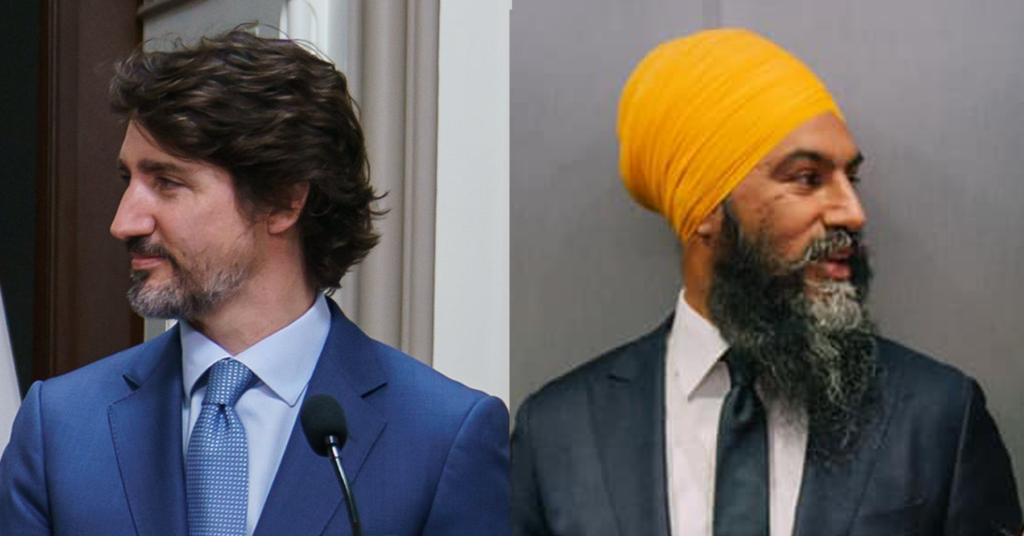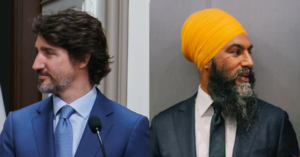
Why Justin Trudeau and Jagmeet Singh Are Taking Very Different Positions on Private, For-Profit Long-Term Care
Trudeau and Singh’s positions highlight how each leader is directing their messages at different audiences
It’s often said all politics is theatre, and when said most cynically, it’s the sort of toss-off comment perhaps breezily made by those with no stake in what’s at play. But it is true that political conflict always plays out to multiple audiences in theatres mostly separate and unseen from each other.
In the current debate over long-term care, just one of many policy points in play in current federal Canadian politics, we can see the outline of that conflict.
20 Ontario long-term care homes owned by Chartwell racked up a hundred regulatory infractions last year.
They detail cases where Chartwell allegedly failed to address abuse, prevent injuries, maintain facilities or contain the spread of COVID-19.https://t.co/Z3da3sgBzW #onpoli
— PressProgress (@pressprogress) January 22, 2021
To analyze conflict, political scientists commonly focus on four theatres of politics, each with its own audience and dynamics. In these four theatres, each political party engages with other political parties, voters, their own members and organized stakeholders, such as lobby groups.
An analysis of the dynamics in these four theatres can be an entry point for political parties to develop strategies to win their policy objectives.
For the conflict between federal parties on long-term care, each has staked out its position. The Conservatives oppose a transition to non-profit operations and Bloc Québecois oppose any federally imposed standards . Liberals oppose a non-profit transition but support voluntary national standards that can be adopted by provinces. New Democrats support national standards set out in federal law tied to a transition to a non-profit model.
In the theatre of voters, NDP Leader Jagmeet Singh starts with a big advantage against his Liberal rivals. An Ipsos-Reid survey from last December found 86% believed long term care should be part of our public health care system and 75% said long term care homes should be run by the same bodies that run our hospitals and clinics. An earlier poll from Angus Reid showed 66% of Canadians want long-term care nationalized.
First, it’s not clear what Trudeau means by national standards. Second, it’s equally unclear whether devising such standards would solve the problems facing long term care, Thomas Walkom writes.https://t.co/ptliCULpxe
— Toronto Star (@TorontoStar) October 17, 2020
That breadth of support suggests that among their own members, other parties may have problems. With such a massive proportion of Canadians wanting reform, it’s hard to believe it’s not a sentiment within their own parties.
Within the Conservatives, support might be stronger among social conservatives than market libertarians. And social liberals might be more interested than business liberals. We can probably safely assume Singh’s position has strong and broad support among his party members.
But while Singh is on stronger ground than Trudeau with voters and probably party members, that won’t be the case in the battle for stakeholders. Singh’s position may be shared by unions, especially those representing long-term care workers and nurses, and some other health advocacy groups. But without doubt, the multi-billion-dollar private long-term care industry isn’t going to endorse his plan — which gives a multi-billion reasons to attack Singh’s plan and like Trudeau’s.
Over 80% of the people we have lost, in Canada, to COVID-19 have been seniors in long term care homes
Some of the worst conditions have been in private homes
This is heartbreaking
Private long term care has no place in our healthcare systemhttps://t.co/fxkWUWnMP1
— Jagmeet Singh (@theJagmeetSingh) May 11, 2020
But the point of this analysis isn’t just to report where things are at. It’s to think about a strategy that will drive matters to a new place — to where those of us with social democratic instincts believe Canadians will receive better care.
Strategy is really no mystery to us. We use it in our everyday life to make things happen. We plan a strategy for our trip to the grocery store. We use strategy when we plan our cooking so everything comes out ready at the same time – or at least try. Mostly, it’s an instinctive effort to corral the resources we have and focus them on our objective.
Theatres of conflict, whether construed as the four analysed here or in another way, are the second-highest level on the strategy board of political parties. Theatres are nearly-discrete arenas of conflict. They have their own contours — areas of strength, opportunities, dangers and weakness.
Within each theatre, one level further down, parties develop operational strategies to take advantages, strengthen strengths and gain ground. At this operations level the quality of leadership, particularly the ability to effectively use timing or surprise, is an important factor.
Operations co-ordinate tactics, the many specific engagements with political adversaries. Tactics include press conferences, social media campaigns, talking points and other jabs and heave-ho efforts of daily politics. And one more level down, tactics use technical materials — the tools, equipment, writing, research, software and hardware that underlie tactical engagements.
When all the technical, tactical, operational and theatre efforts are co-ordinated and inter-related towards a goal, it’s called grand strategy — or, more commonly, just strategy.
In launching his campaign for long-term care reform, Singh’s NDP goal is to win his reforms. And while he has several advantages already working for him, the real question Singh faces is whether, by working at the grand strategy level, he can strengthen his strengths and guard his weaknesses.
If Singh’s NDP does have strong backing for its long-term care proposals among NDP members, that’s perhaps a strength to be leveraged. With an operation that puts some technical resources and tactical co-ordination behind party volunteers, voters’ awareness of Singh’s plan and its association with his party might be increased.
There could be targeted efforts to peel off voters. The hunch that social liberals and social conservatives may be more likely than others to support Singh’s position could be tested by polling and their reasons for their support could be probed. Specific tactical engagements could be developed for them.
That Canadians so widely support his plan suggests Singh’s NDP should also create ways to keep his proposal in public view. New research, stories, successful models from other countries and other technical elements should be developed to fuel tactics that boost awareness. In fact, the broad support among Canadians is itself a story; New Democrats might want to develop more polling data and tactics to spread it.
But it’s not just about strengthening strengths. Without a plan to defend against the institutional opposition of long-term care stakeholders and their richly-funded, non-transparent public relations campaigns, Singh’s reform plan may struggle and Trudeau may benefit. In the stakeholder theatre, long-term care companies are deeply engaged with Liberals and Conservatives.
The industry’s relationship with sympathetic provincial premiers, who are widely covered in media, also presents the possibility of deeply-researched political messaging being used in the voter theatre to undermine support for Singh’s plan.
The point in any of these possibilities – or the many not yet imagined – is that politics isn’t a static or flat world. Strategy flows across levels to rally new forces, guard weakness and resource stronger lines of attack. But the most important point is good policy doesn’t sell itself. Politics is always a fight.
Our journalism is powered by readers like you.
We’re an award-winning non-profit news organization that covers topics like social and economic inequality, big business and labour, and right-wing extremism.
Help us build so we can bring to light stories that don’t get the attention they deserve from Canada’s big corporate media outlets.
Donate



